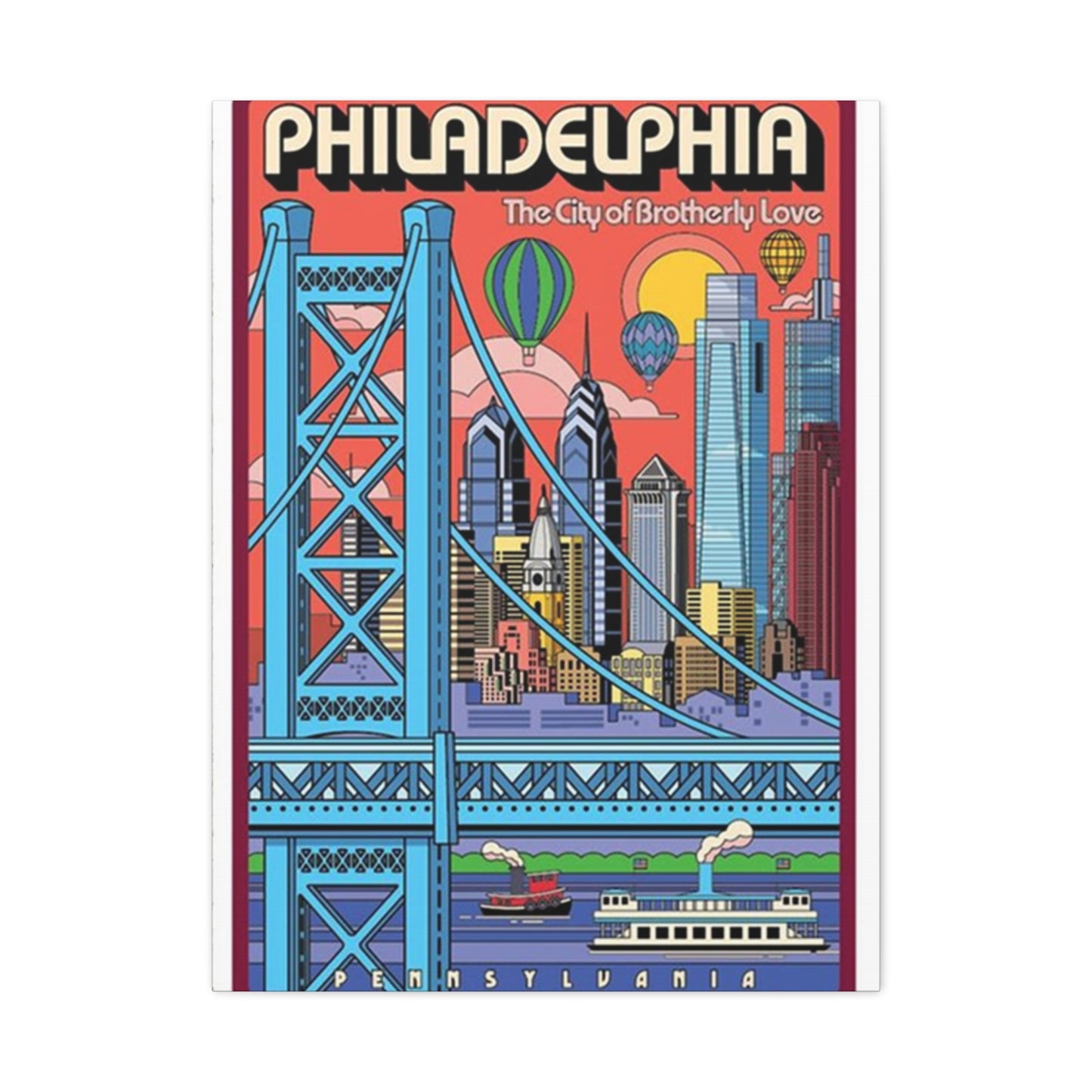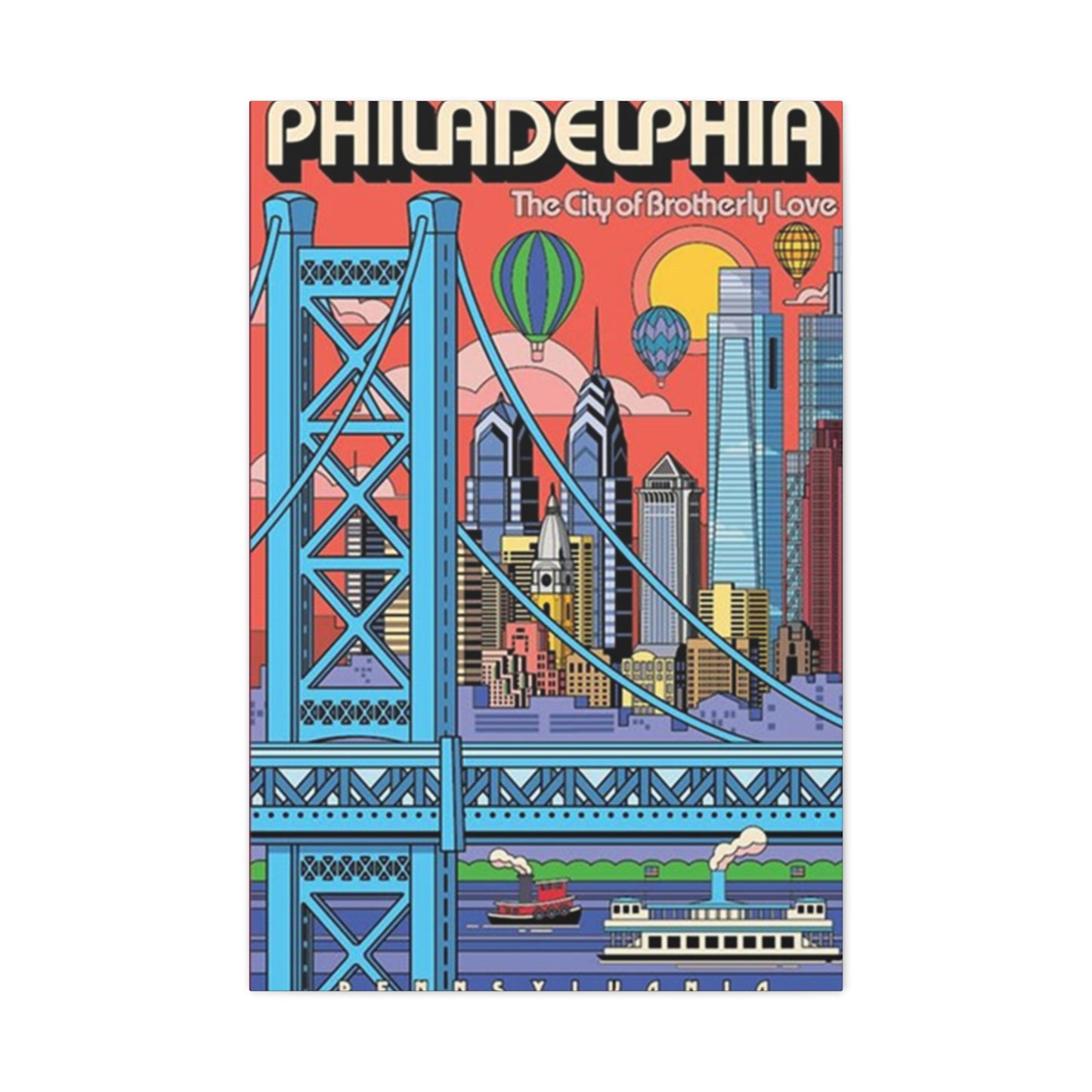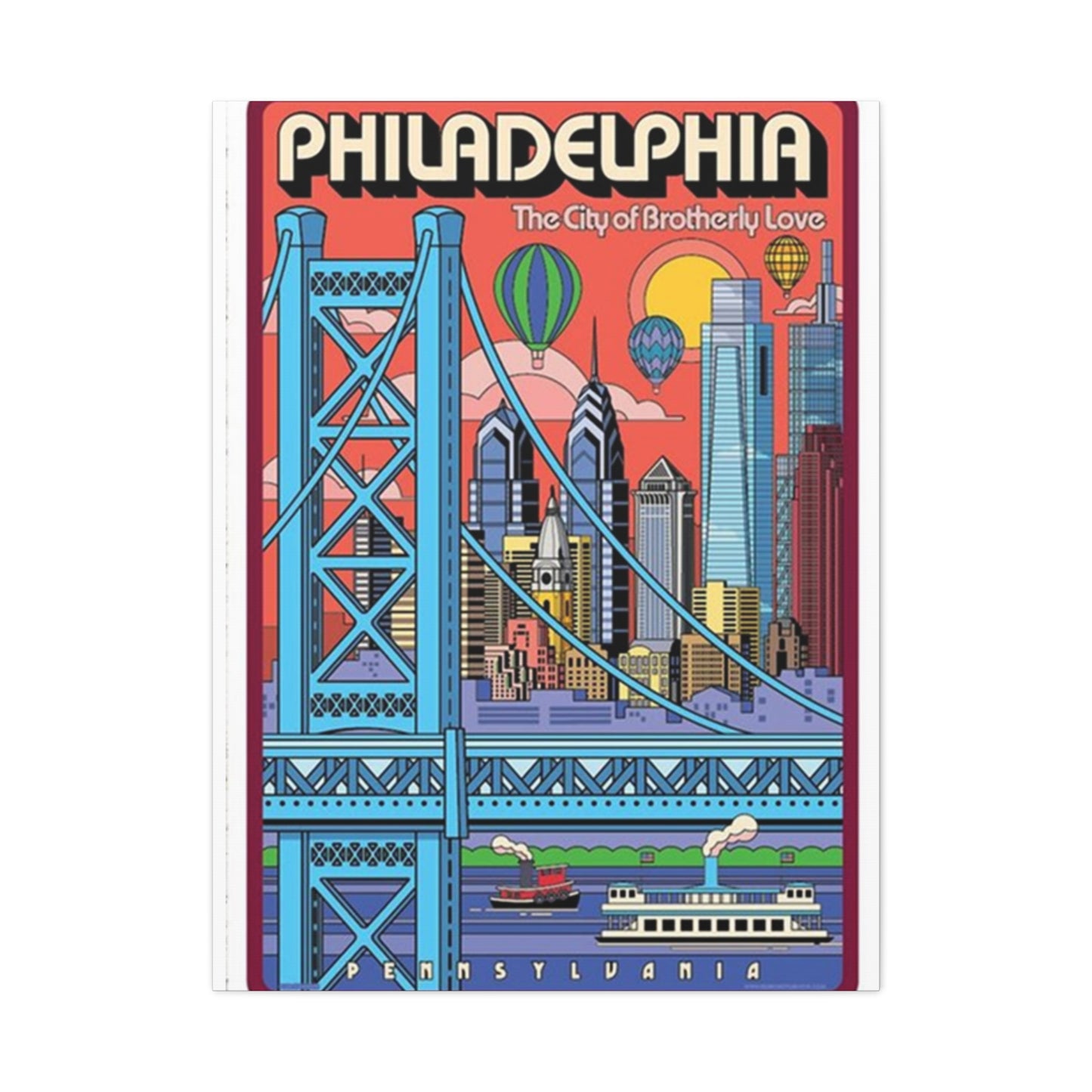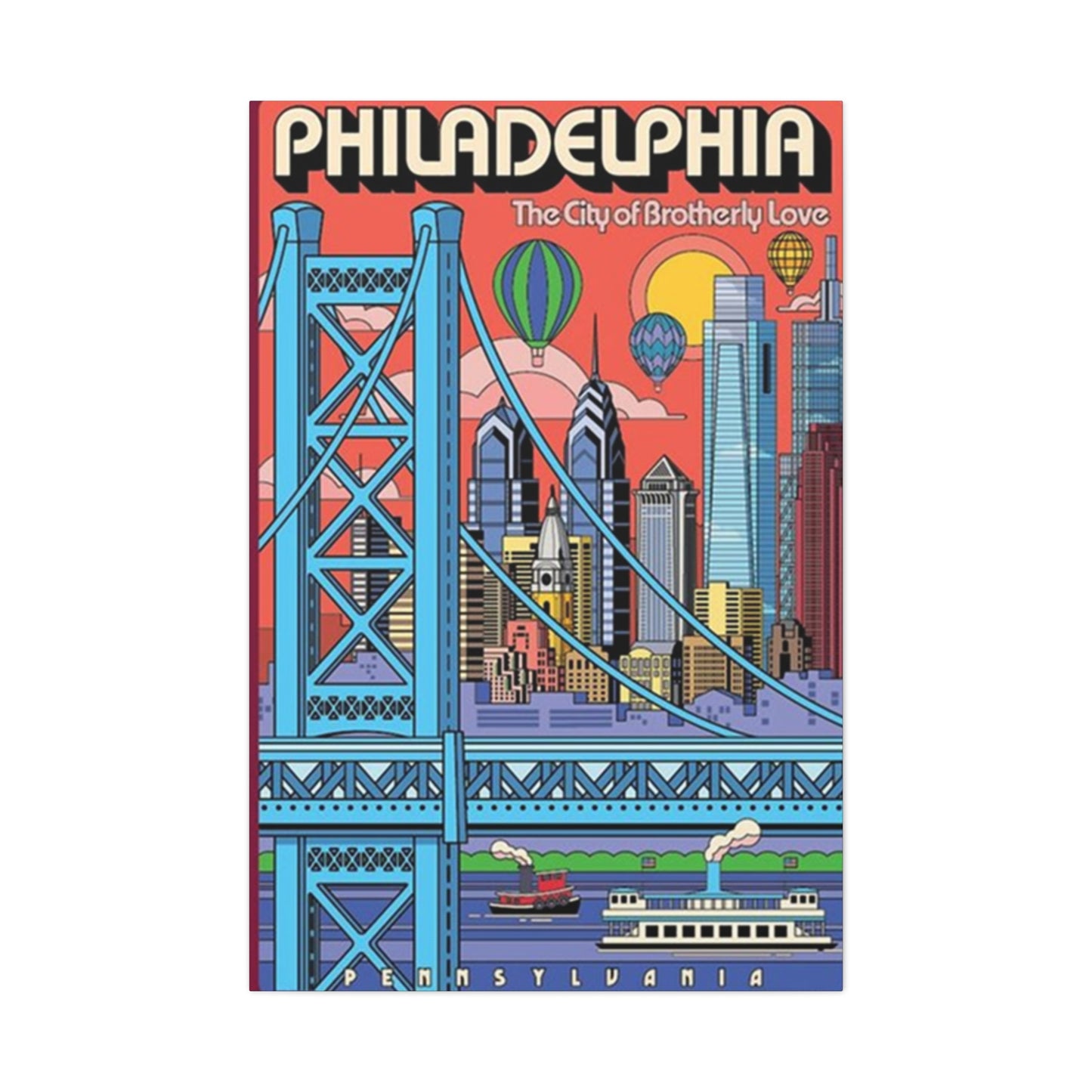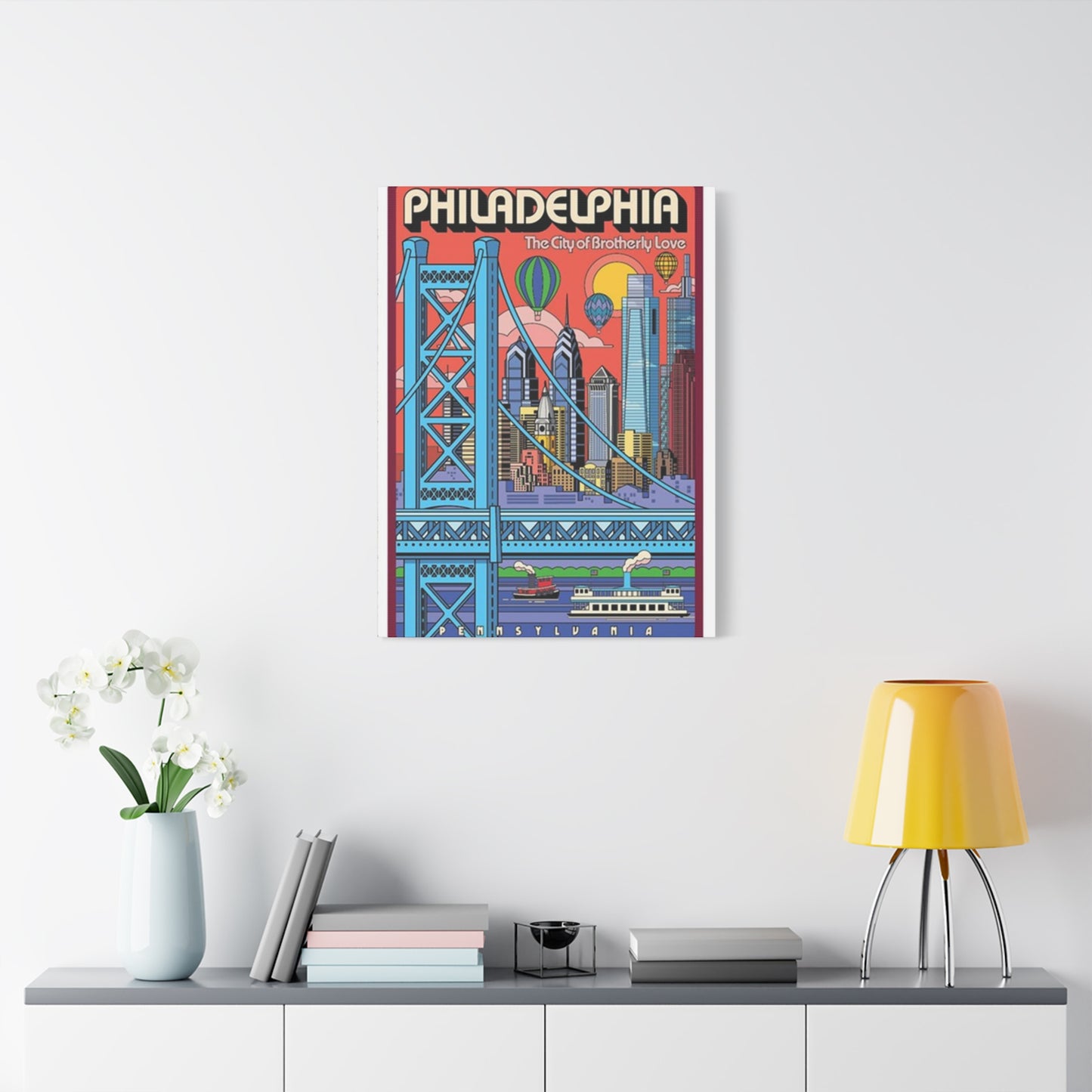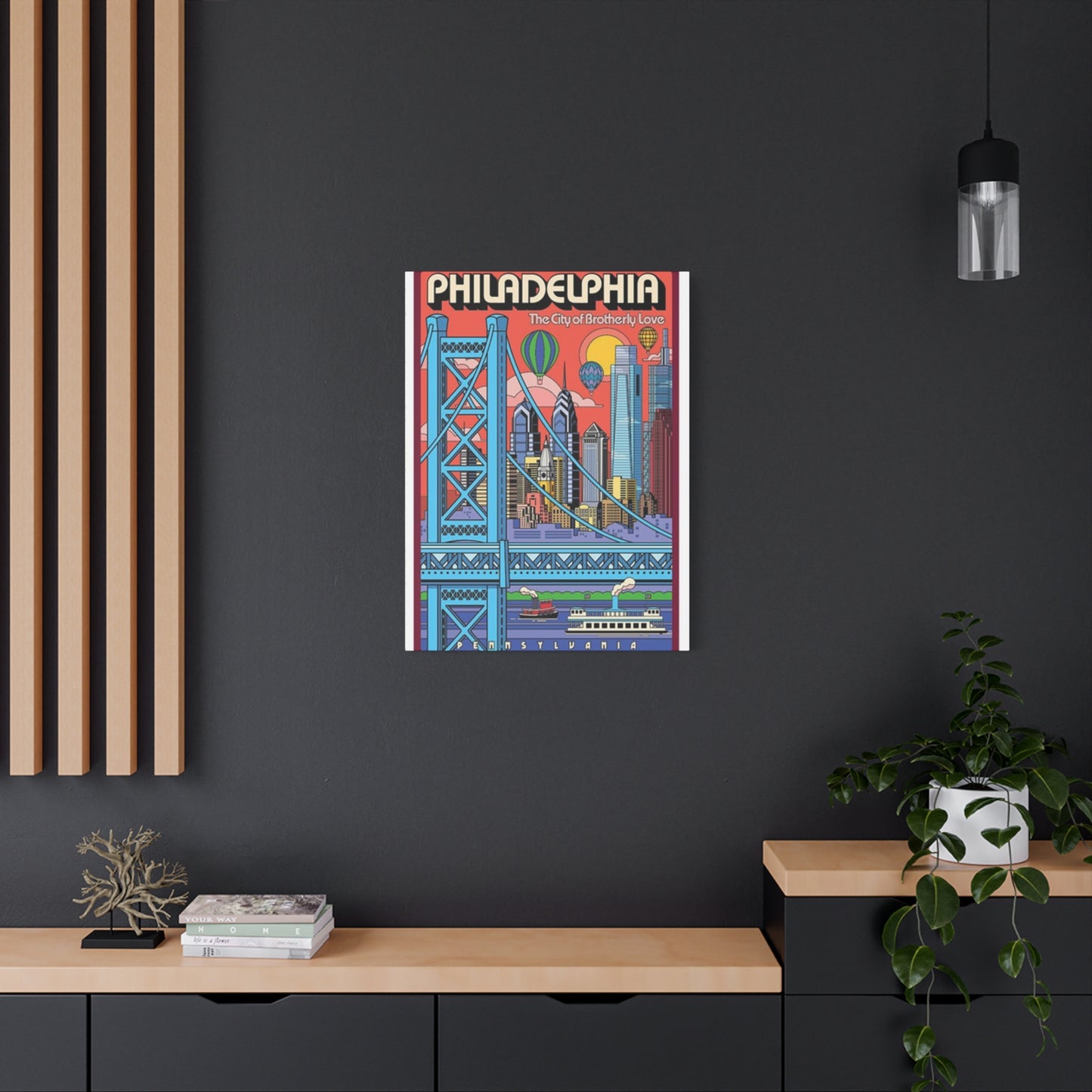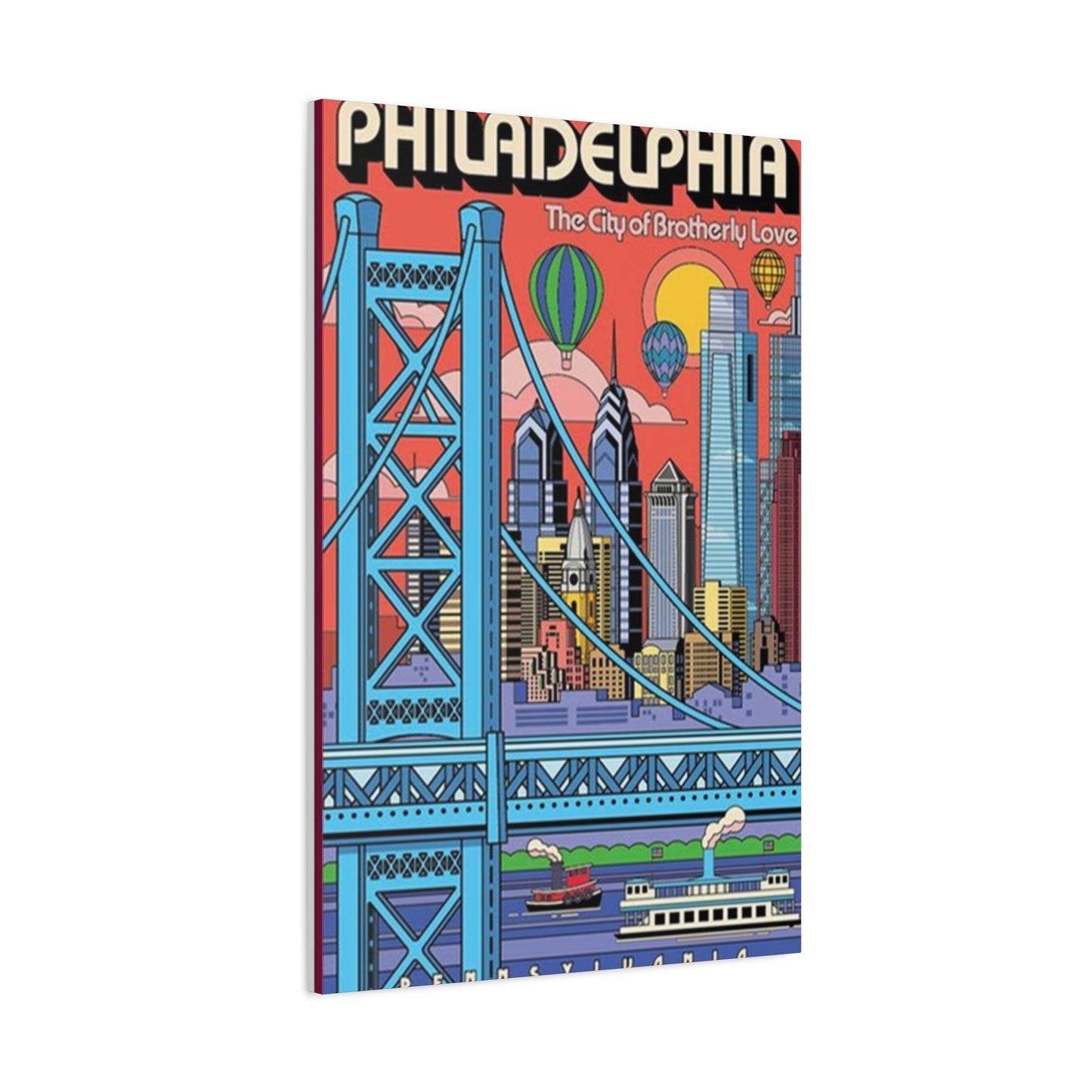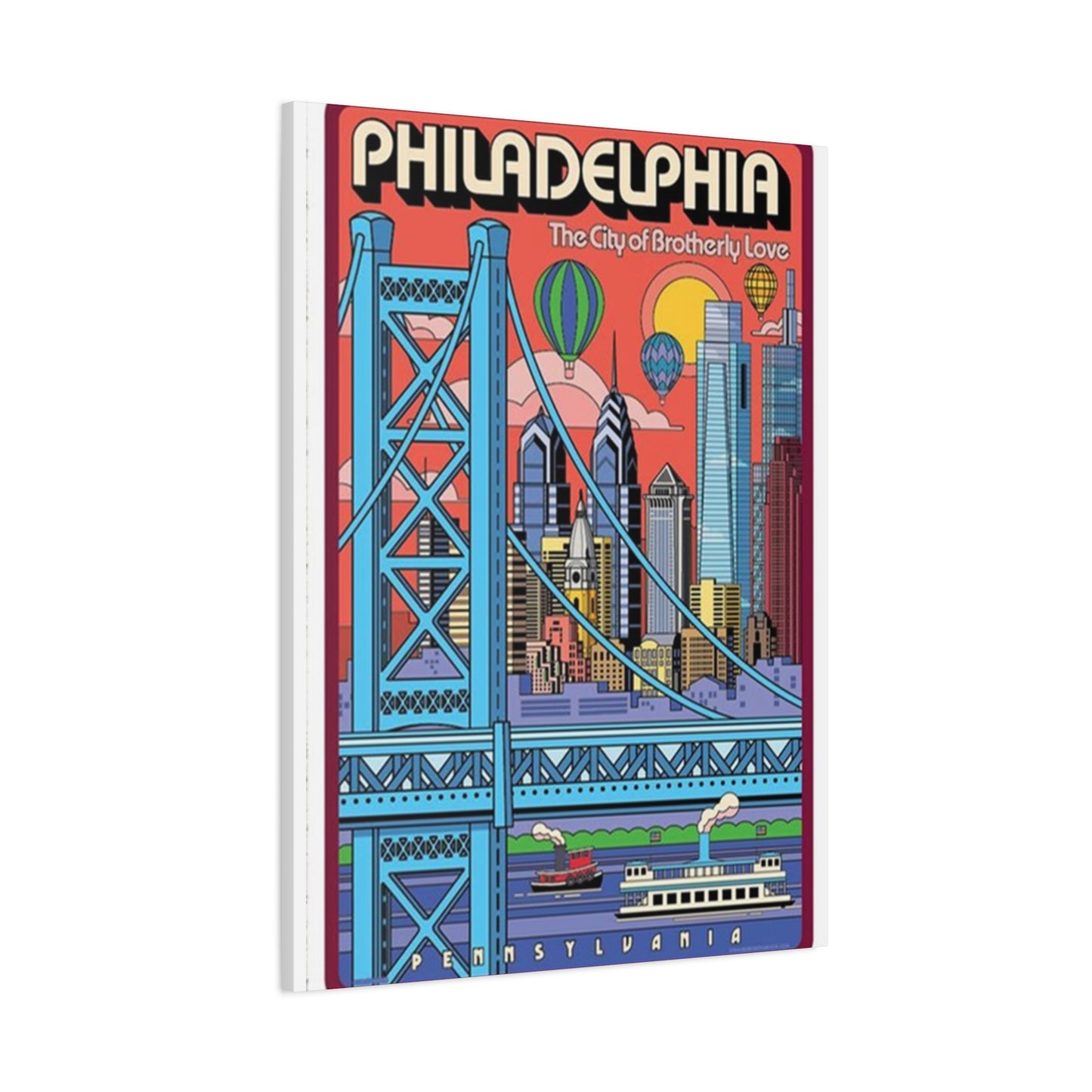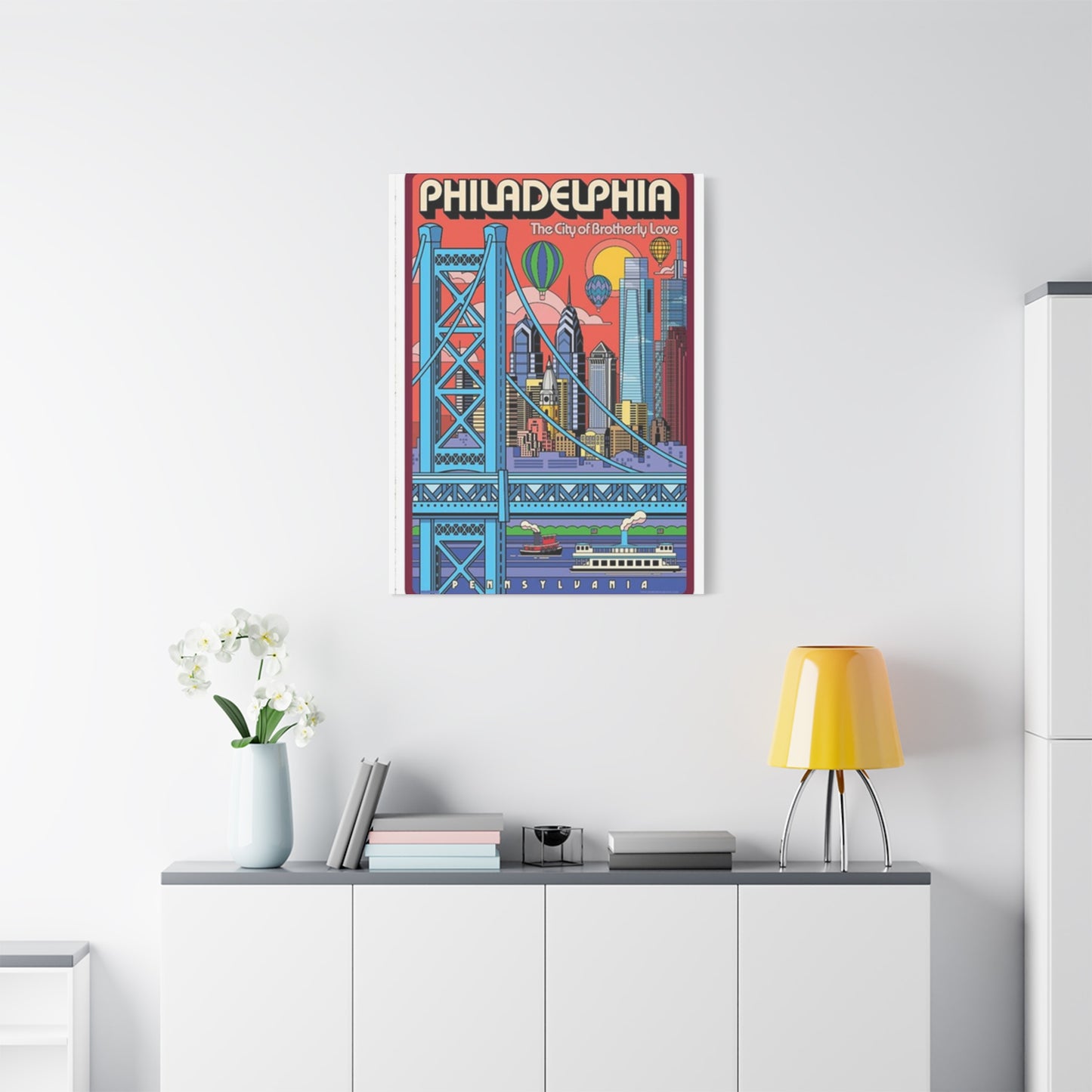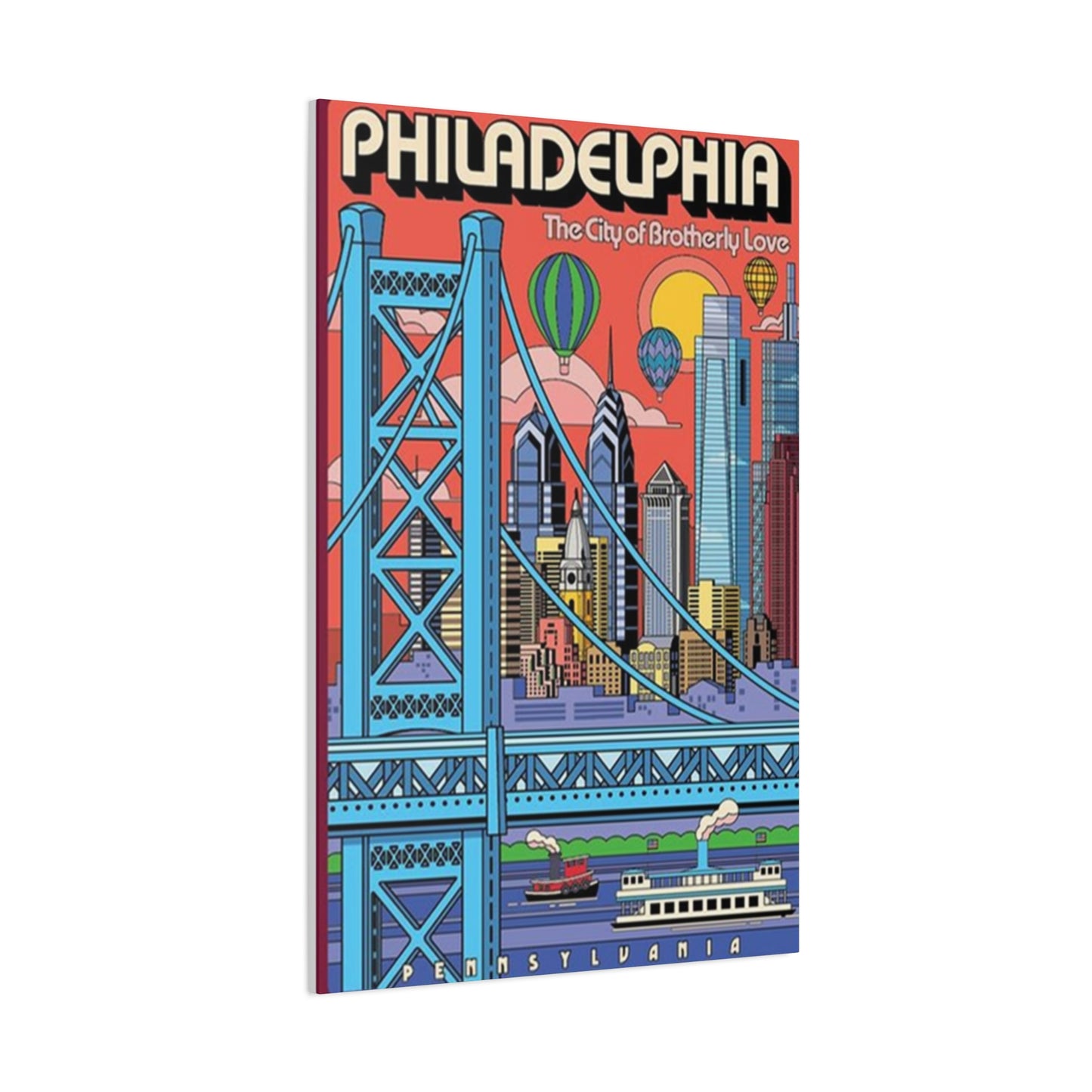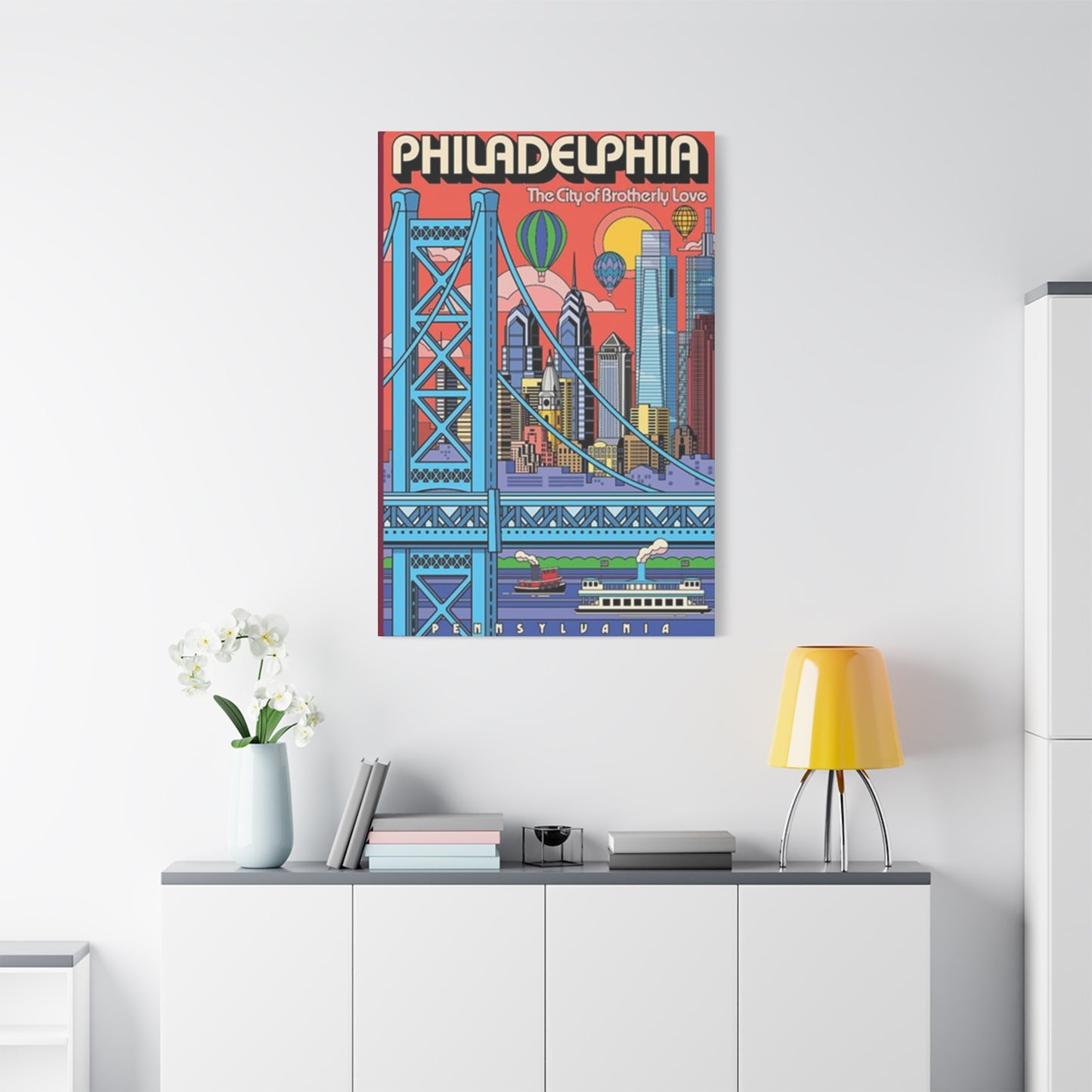Celebrating Brotherhood in Art: The Heartwarming Appeal of Brotherly Love Poster Wall Art
Philadelphia stands as one of America's most historically rich and culturally vibrant cities, earning its famous nickname through centuries of tradition, unity, and community spirit. For residents and admirers alike, displaying artwork that captures this essence creates a powerful connection to the city's soul. The visual representation of Philadelphia's identity through carefully crafted wall decorations allows individuals to bring the energy, history, and warmth of this remarkable metropolis into their personal spaces.
Artwork celebrating Philadelphia's nickname serves multiple purposes beyond mere decoration. These pieces act as conversation starters, expressions of local pride, and reminders of the values that have defined this city since its founding. Whether you're a lifelong resident, a transplant who has fallen in love with the area, or someone who simply appreciates the historical significance and cultural richness of this Pennsylvania metropolis, incorporating themed artwork into your living or working environment creates an atmosphere that reflects your connection to one of America's most beloved cities.
The market for Philadelphia-themed wall decorations has expanded significantly in recent years, reflecting both the city's growing population and the increasing trend of personalized home decor. People no longer settle for generic artwork that could belong anywhere. Instead, they seek pieces that tell their story, represent their values, and connect them to places that hold meaning in their lives. For those with ties to Philadelphia, few images capture the city's spirit more powerfully than artwork celebrating its foundational principle of fellowship and community.
Expressing Philadelphia Affection Through Visual Displays
The desire to showcase loyalty and affection for Philadelphia runs deep among those who call the city home or have experienced its unique character. Visual displays featuring the city's famous moniker create an immediate visual impact that communicates volumes about the inhabitant's identity and values. Unlike generic cityscapes or impersonal abstract pieces, these specific designs carry meaning that resonates with anyone familiar with Philadelphia's history and culture.
When selecting pieces to display, individuals consider various factors including color schemes, design styles, and the specific message they want to convey. Some prefer bold, graphic interpretations that make a strong statement, while others gravitate toward subtle, sophisticated designs that hint at their Philadelphia connection without overwhelming the space. The beauty of themed artwork lies in its versatility, allowing for expression across a spectrum of aesthetic preferences.
The psychological impact of surrounding yourself with imagery that reflects your identity and values should not be underestimated. Environmental psychology research demonstrates that our physical surroundings significantly influence our mood, productivity, and overall wellbeing. When your home or office features artwork that connects you to a place you love, it creates a sense of belonging and comfort that extends beyond the purely visual. Each glance at a Philadelphia-themed piece can trigger positive memories, reinforce your identity, and provide a grounding sense of place.
For those who have moved away from Philadelphia, these visual reminders serve an especially important function. They maintain a connection to the city during physical separation, keeping the spirit of the place alive in daily consciousness. Many former residents report that having Philadelphia-themed decorations in their new homes helps combat homesickness and maintains their sense of identity even when living elsewhere. The artwork becomes a portal to memories, experiences, and the community they left behind.
Capturing Philadelphia's Character in Decorative Pieces
Philadelphia's character emerges from a complex blend of historical significance, cultural diversity, architectural beauty, and community spirit. Translating these intangible qualities into visual art requires both skill and understanding of what makes the city unique. The most effective pieces don't simply reference the city's nickname but capture the feeling of walking through historic neighborhoods, the energy of bustling markets, the pride in local sports teams, and the warmth of tight-knit communities.
Artists and designers who create Philadelphia-themed work often draw inspiration from multiple sources. The city's colonial architecture provides visual elements that immediately signal place and time. The distinctive color palettes associated with various neighborhoods, from the earth tones of historic districts to the vibrant hues of modern murals, offer opportunities for creative interpretation. Typography choices can reference everything from historic documents to contemporary street art, each carrying different connotations and appealing to different audiences.
The most successful pieces achieve a balance between specificity and universality. They're clearly identifiable as Philadelphia-related to those familiar with the city, yet retain enough aesthetic appeal to work as standalone art for viewers without that context. This balance ensures the artwork functions effectively in diverse settings, from intimate home spaces to professional offices, from casual entertainment areas to formal living rooms.
Color plays a crucial role in the effectiveness of Philadelphia-themed artwork. While some pieces incorporate the city's official colors or those associated with beloved sports teams, others take a more nuanced approach, using palettes that evoke the city's atmosphere without literal representation. Warm tones can suggest the welcoming nature implied by the city's nickname, while cooler, more sophisticated palettes might appeal to those drawn to Philadelphia's role as a major metropolitan center. The choice of color scheme dramatically affects both the emotional impact of the piece and its compatibility with various interior design styles.
Decorative Elements Celebrating Pennsylvania's Largest Metropolis
Creating a cohesive interior design scheme that celebrates your connection to Pennsylvania's largest city involves more than simply hanging a single piece of artwork. It requires thoughtful consideration of how different elements interact, complement each other, and contribute to the overall atmosphere you want to create. Philadelphia-themed decorations can serve as focal points around which entire rooms are designed, or they can function as subtle accents within broader design schemes.
When incorporating these pieces into your space, consider the architectural features of your home or office. Older buildings with traditional architecture might pair beautifully with vintage-inspired designs that echo Philadelphia's colonial heritage. Modern spaces with clean lines and minimalist aesthetics might better accommodate contemporary interpretations that use graphic design principles to distill the city's essence into bold, simple forms. The goal is creating harmony between the artwork and its surroundings rather than forcing elements that clash with the existing environment.
Scale and placement significantly impact the effectiveness of any wall decoration. A large, bold piece can serve as the focal point of a room, immediately drawing the eye and setting the tone for the entire space. Smaller pieces might work better as part of a gallery wall, where multiple related images create a cumulative effect that's greater than the sum of individual parts. Consider the viewing distance and angles when selecting sizes and placement locations. A piece meant to be viewed from across a large living room needs different characteristics than one designed for close inspection in a hallway or staircase.
The framing and presentation of your artwork also deserves careful attention. The frame acts as a transition between the artwork and the wall, and the right choice can enhance the piece while the wrong one can detract from its impact. Traditional wood frames might suit vintage-inspired designs, while sleek metal frames often complement contemporary graphics. Some pieces work best with minimal framing or even frameless mounting, allowing the image itself to take center stage without visual competition from borders and matting.
Philadelphia Appreciation Through Wall Decorations
Wall decorations serve as one of the most accessible and impactful ways to personalize any space. Unlike furniture or architectural elements, which involve significant investment and commitment, artwork can be changed relatively easily, allowing for evolution as tastes develop and circumstances change. For Philadelphia enthusiasts, themed wall decorations offer an opportunity to make a statement about identity and values while maintaining flexibility in overall design approach.
The range of available styles ensures that virtually anyone can find Philadelphia-themed artwork that aligns with their aesthetic preferences. Traditional illustrations might appeal to history enthusiasts and those who appreciate classic artistic techniques. Contemporary graphic designs attract individuals drawn to modern aesthetics and bold visual statements. Photographic representations offer realism and documentary quality that some viewers prefer. Artistic interpretations that blend multiple styles or take creative liberties with representation appeal to those who want something unique and unexpected.
Quality considerations should guide your selection process. While budget constraints are real for most people, investing in well-crafted pieces typically provides better long-term value than purchasing multiple low-quality items. High-quality printing techniques ensure colors remain vibrant and details stay sharp over time. Durable materials resist fading, warping, and other forms of degradation that can ruin artwork prematurely. Professional finishing touches like proper mounting and protective coatings extend the life of your investment while maintaining its visual appeal.
The emotional resonance of your chosen artwork matters as much as its technical quality. A piece might be expertly crafted and beautifully designed, but if it doesn't speak to you personally, it won't provide the satisfaction you're seeking. Take time to consider what aspects of Philadelphia matter most to you. Is it the revolutionary history? The vibrant neighborhoods? The sports culture? The arts scene? The culinary traditions? Identifying what draws you to the city helps narrow down options to pieces that will provide lasting enjoyment rather than temporary appeal.
Hometown Pride Displayed Through Artistic Creations
Pride in one's hometown represents a fundamental human emotion that transcends simple boosterism. It reflects our need for belonging, our appreciation for the places that shaped us, and our desire to be part of something larger than ourselves. For Philadelphians, this pride carries particular weight given the city's outsized role in American history and its continuing influence on national culture. Displaying artwork that celebrates this connection makes private feelings visible and creates opportunities for sharing enthusiasm with others.
The expression of hometown pride through artwork varies significantly based on individual personality and circumstances. Some people prefer loud, unmistakable declarations of their Philadelphia loyalty, selecting pieces with prominent text, bold graphics, and undeniable city references. Others favor subtler approaches, choosing artwork that insiders immediately recognize but that might not be obvious to casual observers. Both approaches have merit, and the choice depends on personal comfort levels with public displays of affection for place.
Group identity plays an important role in hometown pride. Supporting local sports teams, frequenting neighborhood businesses, participating in community events, and yes, displaying Philadelphia-themed artwork all serve as visible markers of group membership. These displays signal to others that you share common values, experiences, and loyalties. In neighborhoods with high concentrations of Philadelphia natives or enthusiasts, such displays can facilitate social connections and strengthen community bonds. Even in areas where Philadelphia connections are less common, the artwork can serve as an icebreaker that helps identify fellow enthusiasts.
The relationship between physical place and personal identity has been extensively studied by social psychologists and cultural geographers. Research consistently shows that people incorporate aspects of meaningful places into their self-concept. When you say you're from Philadelphia, you're not just stating a geographic fact but making a claim about who you are as a person. The characteristics you associate with the city become, in part, characteristics you associate with yourself. Displaying artwork that celebrates Philadelphia reinforces this aspect of identity both to yourself and to others who enter your space.
Residential Atmosphere Enhanced by Philadelphia Imagery
The atmosphere of your home profoundly affects your daily experience of life. Environmental factors including color, light, spatial arrangement, and yes, artwork, all contribute to the overall feeling of your living space. For Philadelphia enthusiasts, incorporating themed imagery into home decor creates an atmosphere that reflects personal identity and values while potentially providing psychological benefits that come from surrounding yourself with meaningful symbols.
Different rooms call for different approaches to Philadelphia-themed decor. Living rooms and family rooms, where guests are entertained and family members gather, might accommodate bolder, more prominent displays that serve as conversation pieces and clear expressions of household identity. Bedrooms and private spaces might benefit from subtler, more personal pieces that provide comfort and connection without overwhelming relaxation-focused environments. Home offices can feature professional-looking designs that maintain personality while projecting appropriate seriousness for work-related activities.
Creating visual flow throughout your home involves coordinating various design elements so that moving from room to room feels coherent rather than disjointed. When incorporating Philadelphia-themed artwork into multiple rooms, consider how the pieces relate to each other. They don't need to match exactly, which can feel monotonous, but should share some unifying characteristics whether that's color palette, style, or thematic approach. This coordination creates a sense that the home's design was thoughtfully planned rather than randomly assembled.
Lighting dramatically affects how artwork appears and the atmosphere it creates. Natural light changes throughout the day, affecting colors and visibility. Artificial lighting can be designed to enhance specific pieces, using techniques like picture lights, track lighting, or strategic placement of lamps. Consider lighting conditions when selecting and placing Philadelphia-themed artwork. A piece that looks perfect in the store under artificial lighting might appear different in your home's natural light conditions. Similarly, positioning that works well during daytime might prove problematic in evening hours when relying on artificial illumination.
Nostalgic Elements in Contemporary Philadelphia Art
Nostalgia plays complex roles in how we relate to places, mixing genuine memory with idealization and selective focus. For many people, particularly those who no longer live in Philadelphia, nostalgia significantly colors their relationship with the city. Artwork that effectively taps into this nostalgic feeling can be particularly powerful and emotionally resonant, though the challenge lies in balancing nostalgia with contemporary relevance and avoiding overly sentimental approaches that might not age well.
The aesthetics of nostalgia have become increasingly popular in contemporary design across various fields. Vintage-inspired designs, retro color palettes, and references to past decades appear everywhere from fashion to product design to graphic art. Philadelphia-themed artwork participates in this broader trend, with many pieces adopting aesthetic approaches that evoke various historical periods. These designs appeal to both those old enough to remember the referenced eras and younger audiences drawn to retro aesthetics without direct memory of the periods in question.
Authenticity becomes a concern when creating nostalgic artwork. Designs that successfully evoke nostalgia while maintaining contemporary relevance typically achieve this balance through careful attention to detail and avoidance of clichéd approaches. They reference the past without simply copying it, acknowledging historical aesthetics while bringing contemporary design sensibilities to bear. This approach creates pieces that feel both familiar and fresh, comforting yet current.
Personal versus collective nostalgia creates different types of emotional responses. Personal nostalgia connects to individual memories and experiences specific to each person. Collective nostalgia relates to shared cultural memories that groups of people experienced together or learned about through cultural transmission. Philadelphia-themed artwork can tap into both types, with some pieces evoking personal memories for those who lived specific experiences and others connecting to collective memories about Philadelphia's history, culture, and character that many people share even without direct experience.
Cultural Identity Affirmed Through Visual Expression
Cultural identity encompasses the various characteristics, traditions, beliefs, and practices that define groups and individuals. Geographic identity forms an important component of cultural identity for many people, with the city or region you come from shaping significant aspects of how you see yourself and how others perceive you. Philadelphia's distinctive culture creates particularly strong identity connections, and visual expressions of this identity through artwork serve important psychological and social functions.
The process of identity formation involves both internal reflection and external validation. Displaying Philadelphia-themed artwork in your home serves both functions. Internally, it reinforces your own sense of identity by surrounding you with visual reminders of this aspect of yourself. Externally, it signals this identity to others who enter your space, inviting recognition and validation. This combination of internal and external reinforcement strengthens identity and increases its salience in daily life.
Multiple identities coexist within each individual, and artwork can express various aspects of personal identity simultaneously. Philadelphia-themed pieces might connect to your identity as a Pennsylvanian, as an East Coast resident, as an American with interest in colonial history, as a sports fan, as someone who values community and fellowship, or various other identity components. The most personally meaningful pieces typically resonate across multiple identity dimensions rather than connecting to only single aspects.
Identity performance describes how people actively express and enact their identities through various behaviors and choices. Interior design choices, including artwork selection, represent one form of identity performance. The pieces you choose and how you display them communicate messages about who you are, what you value, and what communities you belong to. Understanding this performative dimension helps explain why artwork selection often involves considerable thought and emotional investment beyond simple aesthetic preference.
Geographic Pride Materialized in Home Furnishings
Geographic pride represents a particular form of place attachment characterized by positive feelings about and loyalty toward specific locations. This pride can attach to various geographic scales from neighborhoods to nations, but city-level pride appears particularly strong and common. Philadelphia inspires fierce geographic pride among residents and former residents, and materializing this pride through home furnishings creates tangible expressions of intangible feelings.
The merchandise industry has responded to demand for location-specific home goods, producing vast arrays of products celebrating various cities and regions. However, mass-produced items often lack the quality, uniqueness, or aesthetic sophistication many consumers seek. The challenge lies in finding pieces that express geographic pride while meeting high standards for design and craftsmanship. The best Philadelphia-themed artwork achieves this balance, functioning as both proud declaration and sophisticated design element.
Authenticity concerns arise with location-specific merchandise. Some items feel genuine and respectful of the place they represent, created by people with real connections to and understanding of the location. Others feel opportunistic, produced by companies simply capitalizing on demand without genuine engagement with the place or its culture. Consumers increasingly seek authenticity, preferring pieces created by local artists or designers with real Philadelphia connections over generic products manufactured without meaningful connection to the city.
The relationship between geographic pride and actual place quality presents interesting questions. Does pride reflect objective qualities of the place, or does it involve subjective attachment that might persist regardless of objective conditions? Research suggests both factors play roles. Places with genuine positive qualities tend to inspire more pride, but emotional attachment can maintain pride even during difficult periods. For Philadelphia, both factors operate: the city possesses genuine qualities worth celebrating while also inspiring attachment that persists through challenges.
Symbolic Representations of Pennsylvania's Premier City
Symbolism allows complex ideas and feelings to be communicated through simple images or objects. Philadelphia has accumulated rich symbolic associations over its long history, providing artists with powerful vocabulary for creating meaningful designs. Understanding these symbols and their various levels of meaning helps both creators and consumers of Philadelphia-themed artwork appreciate the depth of communication possible through visual forms.
The Liberty Bell stands as perhaps the most internationally recognizable Philadelphia symbol, its crack adding poignancy to its representation of freedom and independence. However, its ubiquity in Philadelphia imagery can make it feel overused or clichéd. Contemporary artists face the challenge of incorporating this powerful symbol in fresh ways that honor its significance without simply reproducing it in predictable forms. Successful approaches often involve abstraction, unexpected color treatments, or placement in surprising contexts that force viewers to see the familiar symbol anew.
Benjamin Franklin's association with Philadelphia creates another rich source of symbolic material. His multifaceted accomplishments as scientist, inventor, writer, diplomat, and civic leader embody values that continue to define the city's character. Visual references to Franklin, whether through direct portraiture or allusions to his various activities and inventions, can efficiently communicate complex messages about Philadelphia's identity and values. The challenge lies in avoiding hagiographic treatments that render him as marble monument rather than living inspiration.
The city's street grid provides geometric structure that appears frequently in abstract or minimalist Philadelphia designs. The logical organization of William Penn's original plan, with its named streets and numbered streets creating clear navigation, can be translated into visual patterns that express order, rationality, and good planning while remaining aesthetically interesting. These geometric abstractions work particularly well in contemporary, minimalist interiors where more literal representations might feel incongruous.
Sports Culture Woven into Philadelphia Imagery
Philadelphia's sports culture occupies a central position in the city's identity and provides rich material for artistic interpretation. The passionate loyalty of Philadelphia sports fans has become legendary, and the city's teams have created countless memorable moments that resonate deeply with local residents. While sports-specific artwork serves dedicated fans, broader Philadelphia-themed pieces often incorporate subtle sports references that connect to this important aspect of city culture.
The distinctive colors associated with Philadelphia sports teams provide ready-made palettes for artwork that signals local loyalty without explicitly depicting sports imagery. These color combinations carry strong associations for anyone familiar with the city's sports scene, allowing for coded communication that insiders immediately recognize. Artists can leverage these color associations to create pieces that resonate with Philadelphia sports fans while remaining abstract enough to work in various design contexts.
Underdog mentality characterizes both Philadelphia sports culture and broader city identity. The city's self-perception as scrappy, hardworking, and often underestimated by outsiders shapes everything from business culture to artistic expression. This underdog identity creates particular emotional intensity around sports victories, which feel like validation not just for the team but for the entire city. Artwork that captures this underdog spirit connects to deep currents in Philadelphia psychology.
Championship moments become part of permanent city lore, referenced and celebrated years or decades after they occur. Recent successes have created new shared memories for Philadelphia sports fans, providing material for both sports-specific artwork and broader city representations that acknowledge these important cultural events. For many residents, these moments represent peaks of collective joy and community unity that transcend sports themselves to become significant life memories.
Neighborhood Character Celebrated in Wall Displays
Philadelphia's neighborhood diversity creates a city of multiple distinct communities, each with its own character, history, and culture. While citywide identity remains important, neighborhood identity often matters even more to residents in their daily lives. Artwork celebrating specific neighborhoods or the general concept of neighborhood diversity allows for more granular expression of place attachment while still connecting to broader Philadelphia identity.
Historic neighborhoods provide particularly rich material for artistic interpretation. The preserved architecture, deep history, and distinctive character of these areas create strong visual identities that translate effectively into artwork. Whether focusing on specific architectural details, capturing the overall atmosphere, or abstracting essential qualities into graphic forms, artists can create powerful representations of these special places within the larger city.
Working-class neighborhoods often possess authentic character that distinguishes them from more gentrified or affluent areas. The row houses, corner stores, and street life of these neighborhoods embody particular Philadelphia qualities that many residents consider essential to the city's real identity. Artwork that honors these working-class neighborhoods validates the experiences and environments of many Philadelphians who might not see their communities represented in mainstream city imagery that focuses primarily on historic or tourist districts.
Cultural neighborhoods formed by various immigrant communities add another layer of diversity to Philadelphia's geographic tapestry. Each area reflects the traditions, values, and aesthetics of the community that shaped it, creating distinct visual environments within the larger city. Artists drawing on these cultural influences can create Philadelphia-themed work that acknowledges and celebrates the city's diversity while maintaining connection to overarching city identity.
Culinary Traditions Referenced in Visual Designs
Philadelphia's culinary traditions contribute significantly to city identity and provide material for artistic interpretation that might not immediately seem obvious. From signature sandwiches to distinctive preparation methods, from beloved local restaurants to food traditions associated with various neighborhoods and ethnic communities, food culture weaves throughout Philadelphia life. While less common than architectural or historical themes, culinary references in artwork can effectively communicate Philadelphia identity to those familiar with these traditions.
The informal food culture of certain Philadelphia specialties embodies working-class values and neighborhood authenticity that many residents consider central to city character. Street-level food traditions connect to social life, community gathering, and unpretentious authenticity. Artists referencing these traditions tap into associations that extend far beyond food itself to encompass broader questions about class, authenticity, and what makes Philadelphia distinctive.
Market traditions in Philadelphia date back centuries and continue to play important roles in neighborhood life and city culture. These markets serve as community gathering places, sources of fresh food, and venues for small businesses. Their visual character—the displays of produce, the interaction between vendors and customers, the architectural settings—provides artistic material that connects to themes of community, tradition, and local commerce.
Immigration waves brought diverse culinary traditions that now form part of broader Philadelphia food culture. Neighborhoods known for particular cuisines create distinctive sensory environments where smells, sights, and sounds reflect specific cultural traditions. Artists drawing on these culinary landscapes can create work that celebrates Philadelphia's diversity while acknowledging the specific communities that contribute to the city's rich cultural mix.
Seasonal Variations in Philadelphia Representations
Philadelphia experiences distinct seasons that significantly affect the city's appearance and atmosphere. Artists creating representations of the city can emphasize particular seasons or attempt to capture qualities that persist across seasonal changes. Seasonal artwork allows for rotation and change in home decor, with different pieces displayed at different times of year, or can represent favorite seasons that hold particular significance for individuals.
Winter in Philadelphia brings particular aesthetic qualities that appeal to some artists and audiences. Snow-covered streets and buildings create dramatic visual effects that transform familiar landscapes. The holiday season adds festive elements to the cityscape. The architecture becomes more visible as trees lose their leaves, revealing building forms and urban geometry that foliage obscures during warmer months. Artists emphasizing winter scenes often focus on these qualities, creating pieces that capture the stark beauty of the cold season.
Spring represents renewal and hope, with flowering trees creating spectacular displays in parks and residential neighborhoods. The return of warmth brings people back to streets and outdoor spaces, reanimating neighborhoods after winter's relative quiet. Artists capturing spring often emphasize these qualities of renewal, growth, and returning vitality, using fresh colors and dynamic compositions that express the season's energy.
Summer brings intense heat but also vibrant street life as people maximize time outdoors. Block parties, outdoor dining, park activities, and various festivals create lively atmosphere that defines summer in Philadelphia. The full foliage creates lush green canopies over streets in residential neighborhoods. Artists emphasizing summer often focus on this outdoor vitality and the sense of community that flourishes during warm weather when people gather outside.
Autumn's Embrace in Philadelphia Visual Narratives
Autumn provides perhaps the most visually dramatic season with brilliant foliage colors transforming the landscape. The comfortable temperatures bring ideal conditions for exploring the city. The academic year beginning adds energy from students returning to Philadelphia's numerous colleges and universities. Artists capturing autumn often emphasize these vibrant colors and the transitional quality of the season, creating pieces that celebrate change while acknowledging the approaching winter.
The changing leaves in Philadelphia's many parks and tree-lined streets create natural artwork that inspires human artists to capture and preserve these ephemeral displays. The contrast between architectural permanence and natural transformation offers powerful symbolic possibilities. Fall colors against historic brick buildings create particularly striking visual combinations that appear frequently in Philadelphia-themed artwork emphasizing seasonal beauty.
Each season offers different emotional resonances that artists can emphasize depending on the message they want to convey. Winter might suggest endurance and stark beauty. Spring communicates renewal and possibility. Summer expresses vitality and community. Autumn embodies change and reflection. Selecting artwork that resonates with your personal response to particular seasons allows for deeper connection between your environment and your emotional landscape.
Seasonal rotation of displayed artwork keeps your environment fresh and responsive to the changing year. While permanent pieces provide continuity and stability, incorporating seasonal elements prevents your space from feeling static. This approach mirrors the natural world's cycles and maintains visual interest throughout the year. Philadelphia-themed pieces lend themselves well to this rotating approach, with different designs emphasizing various aspects of city life that become more relevant during particular seasons.
Medical Excellence Represented in City Identity
Philadelphia's medical institutions have achieved international recognition for research, treatment, and education. The city's medical history extends back centuries, with numerous medical firsts occurring within Philadelphia institutions. This medical excellence forms part of the city's identity and contributes significantly to the regional economy. While medical themes might not dominate decorative artwork, acknowledging this dimension of Philadelphia life creates more complete representations of city identity.
The concentration of hospitals, research facilities, and medical schools creates distinctive institutional architecture that marks particular neighborhoods. These large complexes serve as anchors for their communities, employing thousands and drawing patients from wide areas. The visual presence of medical institutions contributes to Philadelphia's urban landscape and signals the importance of healthcare and medical research in city life.
Medical innovation aligns with Philadelphia's broader identity as a place of firsts and innovation. From colonial-era medical advances to contemporary cutting-edge research, the city has consistently contributed to medical progress. This innovative spirit connects to the same qualities that produced political innovation during the revolutionary period and continues to drive progress across various fields. Artwork celebrating Philadelphia's innovative character might reference medical contributions alongside other forms of innovation.
Community health initiatives emerging from Philadelphia's medical institutions demonstrate commitment to the broader population beyond academic medicine. Free clinics, public health programs, and community outreach efforts connect medical excellence to values of service and care that resonate with the city's nickname. These programs embody the principle of fellowship by ensuring medical knowledge and resources benefit everyone rather than only those with means to access elite institutions.
Literary Connections Enriching Philadelphia's Cultural Identity
Philadelphia's literary heritage includes both authors who called the city home and literary references that have shaped how people think about the place. From colonial-era writing to contemporary fiction, Philadelphia appears in American literature in ways that have influenced popular perceptions of the city. Understanding these literary connections adds depth to appreciation of Philadelphia's cultural significance.
Libraries and bookstores scattered throughout the city create infrastructure supporting reading culture and literary community. Independent bookstores serve as gathering places for readers and venues for author events that connect writers with audiences. These spaces embody values of learning, culture, and community that align with the city's broader identity. Artists might reference these literary spaces as symbols of intellectual life and cultural engagement.
The publishing industry presence in Philadelphia, while smaller than in some other major cities, contributes to literary culture and provides employment for people working in various aspects of book production and distribution. This industry presence connects contemporary Philadelphia to its historical role as a major publishing center during earlier periods when the city ranked among America's most important publishing locations.
Literary festivals and reading series create regular events that bring together writers and readers, fostering literary community and showcasing both established and emerging talent. These cultural programs enhance quality of life for residents interested in literature while attracting visitors who contribute to the local economy. The existence of robust literary programming signals a city that values culture and intellectual life beyond economic productivity.
Political Engagement Shaping Philadelphia's Character
Philadelphia's political culture reflects both its historical significance as the birthplace of American democracy and contemporary realities as a major urban center facing typical challenges of poverty, inequality, and fiscal constraints. The city's progressive political leanings distinguish it from surrounding suburban and rural areas, creating interesting regional dynamics. Political engagement varies across neighborhoods and demographic groups but remains higher than in many American cities.
Activism traditions in Philadelphia extend back through civil rights movements, labor organizing, anti-war protests, and various other causes. This activist heritage continues in contemporary movements addressing police reform, education equity, environmental protection, and other issues. The presence of engaged residents willing to organize and advocate for change contributes to civic vitality even when specific efforts face obstacles or achieve limited success.
Government institutions occupy historic buildings that serve as architectural landmarks while housing contemporary governance functions. The visual presence of these civic structures reminds residents of governmental processes and the potential for civic engagement to shape outcomes. Artists incorporating civic architecture reference both historical significance and ongoing governmental functions that affect daily life.
Voter participation rates and political awareness generally exceed national averages, reflecting residents' engagement with democratic processes and belief that political participation matters. This engagement connects to founding-era ideals about democratic governance while adapting to contemporary realities of urban politics. The continuing vitality of democratic participation in the birthplace of American democracy carries symbolic significance that extends beyond local politics.
Religious Diversity in Philadelphia's Social Fabric
Philadelphia's founding principle of religious tolerance established patterns that continue to shape the city's religious landscape. The city hosts diverse faith communities representing major world religions alongside numerous denominations and independent congregations. This religious diversity contributes to social complexity and creates rich cultural environments where different traditions coexist and occasionally interact.
Historic religious buildings contribute to Philadelphia's architectural heritage while continuing to serve congregational functions. These structures range from simple meeting houses reflecting plain religious aesthetics to elaborate buildings showcasing various architectural styles. The preservation of historic religious architecture maintains physical connections to the past while accommodating contemporary worship practices.
Faith communities play significant roles in Philadelphia neighborhoods beyond purely religious functions. Many congregations operate social service programs, provide space for community meetings, sponsor youth activities, and engage in advocacy work addressing neighborhood concerns. This community involvement extends religious institutions' influence beyond their membership and contributes to social infrastructure supporting neighborhood life.
Interfaith cooperation has increased in recent decades as religious communities recognize common interests in addressing social problems and building understanding across differences. These collaborative efforts demonstrate possibilities for productive engagement across religious boundaries while respecting distinct traditions and beliefs. Such cooperation embodies principles of fellowship and mutual respect that align with the city's founding ideals.
Demographic Shifts Influencing Philadelphia's Future
Philadelphia's population has fluctuated significantly over the decades, declining from mid-twentieth-century peaks before stabilizing and recently growing again. Current demographic trends including the return of young professionals, immigrant population growth, and aging of longtime residents create both opportunities and challenges that will shape the city's future character.
The millennial generation's preference for urban living has benefited Philadelphia as young professionals choose city residence over suburban alternatives. This demographic trend has revitalized particular neighborhoods, supported new businesses, and increased demand for urban amenities. However, this influx has also contributed to rising housing costs that create affordability challenges for existing residents with lower incomes.
Immigrant communities continue revitalizing Philadelphia neighborhoods as they have throughout the city's history. New arrivals bring entrepreneurial energy, cultural richness, and connections to global networks that benefit the broader city. The cultural diversity these communities create enriches Philadelphia's social fabric while sometimes creating tensions around resources, political representation, and cultural change.
Aging of longtime residents creates challenges including healthcare needs, fixed incomes pressured by rising costs, and potential isolation as friends and family members move or die. Supporting elderly residents while accommodating new arrivals requires thoughtful policies and community initiatives. Multigenerational neighborhoods where elderly residents remain connected to community life maintain social cohesion and preserve institutional memory.
Academic Research Advancing Philadelphia's Knowledge Economy
Research conducted at Philadelphia's universities advances knowledge across numerous fields while contributing to economic development through technology transfer, startup formation, and skilled workforce development. This research enterprise positions Philadelphia as a knowledge economy center where intellectual capital generates economic value and enhances quality of life through improved healthcare, environmental solutions, and social innovations.
Medical research particularly distinguishes Philadelphia's academic contribution given the concentration of medical schools, teaching hospitals, and research institutes. Clinical trials conducted locally provide early access to promising treatments while advancing medical knowledge. The discoveries emerging from this research enhance Philadelphia's reputation while potentially creating economic opportunities through commercialization.
Technology research and innovation occurring at university labs and private companies positions Philadelphia as an emerging technology center, though the city faces competition from established tech hubs. Supporting technology sector growth requires infrastructure investment, talent retention, and entrepreneurial ecosystem development. Success in building technology economy capacity would diversify Philadelphia's economic base and create high-wage employment opportunities.
Social science research conducted at Philadelphia institutions informs policy debates and practical interventions addressing urban challenges. Studies of education, poverty, crime, housing, and other issues provide evidence for decision-making while training graduate students who become practitioners and scholars working on these problems. This research contributes to making Philadelphia a laboratory for urban innovation and improvement.
Preservation Efforts Maintaining Philadelphia's Heritage
Historic preservation in Philadelphia balances respect for the past with accommodation of present needs and future development. The city's remarkable collection of historic buildings creates both opportunities and constraints, with preservation regulations protecting architectural heritage while sometimes complicating development projects. Navigating these tensions requires ongoing negotiation among stakeholders with different priorities and perspectives.
Preservation organizations work to identify threatened buildings, advocate for protection, educate the public about architectural heritage, and facilitate sensitive rehabilitation of historic structures. These efforts maintain physical connections to the past that would otherwise disappear through demolition or inappropriate alteration. The success of preservation efforts ensures future generations can experience authentic historic environments rather than only reading about vanished architecture.
Adaptive reuse of historic buildings demonstrates possibilities for preserving structures while accommodating contemporary uses. Converting old industrial buildings into residential lofts, transforming churches into cultural venues, or updating commercial buildings for modern office needs shows how historic architecture can remain functional and economically viable. These projects often produce more characterful spaces than new construction while preserving embodied energy and cultural heritage.
Community-based preservation reflects recognition that preservation decisions should involve people who live in affected neighborhoods rather than being imposed by outside experts. Engaging residents in preservation planning ensures efforts respond to community priorities and values. This approach produces preservation outcomes that maintain neighborhood character while supporting community development goals.
Environmental Sustainability in Philadelphia's Urban Future
Environmental sustainability has become increasingly central to Philadelphia's planning and development as climate change awareness grows and resource constraints become apparent. Green infrastructure projects, energy efficiency initiatives, sustainable transportation investments, and various other efforts attempt to reduce environmental impacts while improving quality of life. These sustainability efforts will shape Philadelphia's future character and resilience.
Climate change poses particular challenges for cities including flooding risks, heat island effects, aging infrastructure stressed by extreme weather, and public health impacts. Philadelphia's position along major rivers creates flood vulnerabilities that will increase as climate change produces more extreme precipitation events. Adapting to these realities requires major investments in infrastructure and planning approaches that anticipate changed conditions.
Urban agriculture and community gardens provide multiple benefits including food access, community building, green space creation, and environmental education. These initiatives transform vacant lots into productive landscapes while strengthening neighborhood social networks. The gardens become both practical food sources and symbols of community empowerment and environmental stewardship.
Energy efficiency improvements in Philadelphia's housing stock reduce environmental impacts while lowering costs for residents struggling with utility expenses. Weatherization programs, efficient appliance installation, and renewable energy adoption all contribute to sustainability goals. Making these improvements accessible to lower-income residents ensures environmental benefits reach everyone rather than only those with means to invest in efficiency.
Social Services Supporting Philadelphia Communities
Social service organizations provide crucial support for Philadelphia residents facing various challenges including poverty, homelessness, mental health issues, addiction, domestic violence, and numerous other difficulties. These organizations fill gaps in government services while advocating for policy changes and coordinating resources to maximize impact. The social service sector employs thousands while serving populations whose wellbeing affects overall community health.
Food security programs address hunger and malnutrition through food banks, meal programs, and benefits assistance. Despite Philadelphia's economic activity, many residents struggle to afford adequate nutrition. Food security initiatives provide immediate relief while working toward longer-term solutions that address root causes of food insecurity including poverty and unemployment.
Homelessness services attempt to move people from streets and shelters into stable housing while addressing underlying issues that often contribute to housing instability. These services range from emergency shelter to transitional housing to permanent supportive housing with wraparound services. The complexity of homelessness requires coordinated responses addressing mental health, addiction, employment, and other factors beyond simple lack of housing.
Youth programs provide positive activities, mentorship, and skill development for young people particularly in under-resourced neighborhoods. These programs attempt to create opportunities and support that help youth develop successfully while avoiding negative outcomes. The investment in youth development represents commitment to Philadelphia's future and recognition that supporting young people benefits entire communities.
Conclusion:
Throughout this exploration of Philadelphia's character and its representation in decorative artwork, consistent themes emerge about what makes this city distinctive and why its residents and admirers feel compelled to express their connection through visual displays in their personal spaces. Philadelphia represents far more than geographic location or demographic statistics. It embodies values, history, culture, and community that shape identities and inspire loyalty among those who experience it.
The city's founding principle of tolerance and fellowship established patterns that continue resonating centuries later. This foundational commitment to community and mutual respect distinguishes Philadelphia from cities founded primarily for commercial or strategic purposes. When people display artwork celebrating the city's famous nickname, they're not simply acknowledging a geographic fact but affirming values of inclusion, community, and human connection that feel increasingly important in fractured times.
Philadelphia's historical significance creates weight and substance that newer cities cannot replicate. Walking streets where revolutionary events unfolded, inhabiting buildings that witnessed crucial historical moments, and participating in traditions extending back generations creates deep time perspective increasingly rare in American culture. Artwork that captures this historical dimension serves as reminder that present actions connect to long chains of human endeavor stretching into the past and extending into the future.
The city's authentic character resists easy categorization or simplification. Philadelphia embraces contradictions, containing both polish and grit, sophistication and earthiness, historic preservation and contemporary innovation. This complexity makes the city endlessly interesting and provides rich material for artistic interpretation. The best Philadelphia-themed artwork captures this complexity rather than reducing the city to simple stereotypes or single dimensions.
Community remains central to Philadelphia's identity in ways that distinguish it from more individualistic urban cultures. Neighborhoods function as real communities rather than simply residential zones. People develop genuine connections to neighbors and local institutions. This community orientation aligns with the city's nickname and creates social fabric that supports residents through challenges while celebrating successes together. Displaying artwork that acknowledges this community dimension affirms its importance and personal commitment to maintaining community values.
The working-class heritage of many Philadelphia neighborhoods grounds the city in authentic experience rather than aspirational image. While gentrification changes some areas, the city retains connections to working-class culture and values that keep it real. This authenticity attracts people tired of superficiality and pretension, offering instead a place where people say what they mean and value substance over style. Artwork capturing this authentic quality resonates with those who appreciate Philadelphia's unpretentious character.
Resilience defines Philadelphia's historical experience and contemporary reality. The city has weathered economic transformations, population losses, fiscal crises, and various other challenges that would have devastated less resilient communities. This resilience flows from strong community bonds, institutional stability, and refusal to give up despite difficulties. Celebrating Philadelphia through artwork acknowledges this resilience and draws inspiration from the city's ability to endure and adapt.

















